Archive for Tips & Ideas
April 14, 2008 at 5:35 pm · Filed under Mobile technology, Tips & Ideas
Coming out of Big Bend I am always reminded of why visitation in the park is not as high as more northern parks. Big Bend is on the way to nowhere, since it borders Mexico and there are no roads across the border there. You have to detour at least 100 miles to get there, and coming out on Rt 385 back to Rt 90 or I-10 involves a couple of hours of driving through a lot of empty desert.
Once we reached Ft Stockton at I-10, around lunchtime, I was pleased to find that my theory about the magazine being somewhat more self-sufficient had held true. I had only two voice mail messages, and neither were business-related. But I didn’t bother to open up the laptop and check email just yet, because I knew I’d have an onslaught of at least a a hundred emails, and probably more.
On I-10 in west Texas the speed limit runs between 80 and 85 MPH (70 -75 for trucks) during the day. It’s tempting to try to tow the Airstream that fast, but there are several good reasons not to. First off, the trailer tire manufacturers recommend limiting speed to 65 MPH. Given all our tire problems lately, I am heeding their advice. The prospect of a blowout still scares me. Second, our fuel economy plummets. At 72 MPH, we burn about 35% more fuel than we do at 65 MPH, and even with all 305 horses pulling hard, the Armada has to downshift frequently to third gear to maintain that speed on hills.
A third reason used to be that the combined rig didn’t handle well at high speed, but that’s no longer true. When we first started tow without the Hensley hitch, 64 MPH was our maximum speed and 59 MPH was max in any sort of wind. With the Hensley we can go as fast as we want with superb handling at all times, but I still prefer to keep it at 65 MPH or less for fuel economy.
Speaking of fuel economy, we paid $3.89 for a gallon of fuel at Rio Grande Village. I’d rather get 10 miles out of that gallon (cost per mile: 39 cents) than 8 miles (cost per mile: 48 cents). When you realize that going 72 MPH saves us 27 minutes on a 300 mile trip (versus going 65 MPH) but costs us $27 more, the choice is pretty obvious.
South Llano River State Park is a fine place to camp, with big grassy campsites and lots of shade trees, but I found no usable Verizon signal here, which meant my phone and Internet connection were inoperable. There’s no wifi to be found either. A neighboring Airstream owner, Sharon, came by and said she’s been using the library’s wifi in town. She’s been here for two weeks waiting for parts to arrive for her late-model 20-foot Safari, which was damaged on the way here.
Sharon’s predicament brings up a cautionary note. The Garmin GPS that we and many others use is a great tool ““ most of the time. But you have to sanity-check it, especially when getting off the highway and going to state parks. The GPS is programmed so that it will choose either the quickest (time) or shortest (mileage) route. This means it will send you down a bumpy dirt road over a one-lane bridge if it calculates that this will shave 10 feet or 10 seconds off your overall trip.
That’s what it did to Sharon. Her GPS said to turn left, and she found herself facing a dead-end that wasn’t in the GPS database “¦ at night “¦ with no one in the truck to help her. She tried to back up in the dark alone and met a tree, which left her with $12,000 worth of aluminum damage and an enforced two-week stay here at South Llano River State Park.
The best strategy is to ignore your GPS when you start seeing the brown state park signs. Those signs will bring you in the best possible way. Don’t trust “Garminita” when she tells you to take a suspicious-looking left down a one-lane road. She’s a handy navigator but she doesn’t know you’re driving a long tall rig that can’t turn around on a dime.
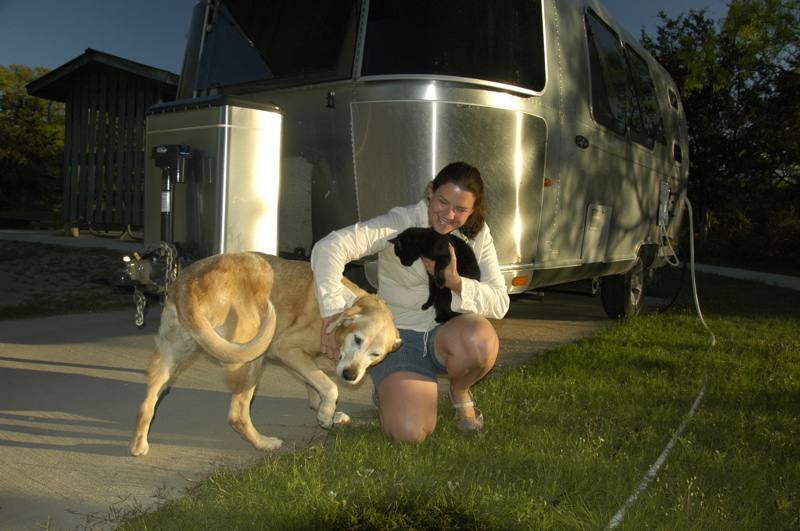 Two weeks of intervening time has given poor Sharon a chance to get over her disaster, and she’s been enjoying the peacefulness of the park while she works remotely on magazine designs for her clients. Since she’s a portable professional like me, the time has been useful and frankly there are a lot worse places to be “stuck” for two weeks than South Llano River State Park.
Two weeks of intervening time has given poor Sharon a chance to get over her disaster, and she’s been enjoying the peacefulness of the park while she works remotely on magazine designs for her clients. Since she’s a portable professional like me, the time has been useful and frankly there are a lot worse places to be “stuck” for two weeks than South Llano River State Park.
For us, however, a move is imminent. I need to spend some heavy time finalizing details for the Summer magazine. It is heading to the printer tomorrow. That means we will move to somewhere that I can get online for a few days.
On Wednesday we will arrive in a favorite spot, Pecan Grove in Austin, for at least two nights. This shady little oasis in the heart of Austin is one of the few urban campgrounds left. I’m hoping some of our friends in the Austin area will come out to meet us there.
November 22, 2007 at 10:40 pm · Filed under Tips & Ideas
We are very busy now, trying to get ready for our vacation next week, so it’s a good thing we got an invitation to Thanksgiving dinner. Eleanor contributed only gravy, and otherwise we left the cooking to our friends (and found ourselves in very good hands, indeed!)
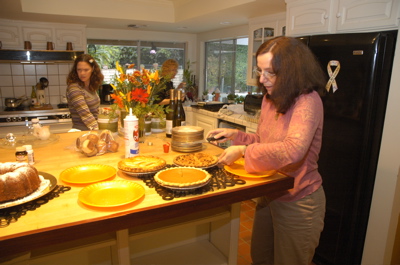
We are busy because we have a plane to catch on Saturday morning, and before then we need to get the Airstream ready for storage, get ahead on work as much as possible, pack, relocate the Airstream to storage (about 100 miles away), and then get ourselves to LAX.
We’ve done this dance before, so we know the steps. A little networking found us a safe place to store the Airstream, and the process of putting it to bed for a week or two isn’t difficult. The fridge will remain running on propane, and the solar panels will keep the batteries topped up. All the really valuable stuff will be with us (mostly the laptops and cameras), and the trailer will be well cleaned so that critters will not be encouraged to sublet the place. It will be ready to go when we return from our trip.
As always on Thanksgiving, I try to give a few minutes to count blessings, and this year we have many. I’m thankful to still be in business doing something I enjoy and which gives us this interesting lifestyle. We’re all in good health, our future is bright (if not totally assured), and the people we care about are all doing well. There are many things to be concerned about but today is not the day for that. Today is the “glass half full” day.
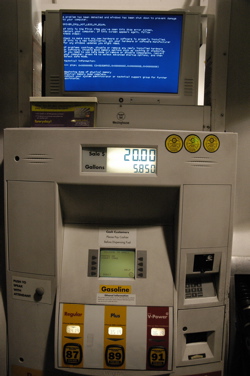 On the way back from dinner tonight we stopped for gas, and I was treated to an increasingly-common phenomenon: an annoying television blasting loud commercials at me about skin cream and bogus ways to make money buying distressed real estate. I’ve encountered this before, but this was the first time I’ve seen one without a “mute” button. (Robert Heinlein foresaw this; I can’t remember if it was in “Podkayne of Mars” or one of his Lazarus Long stories. In the story it was in a taxi cab, and a bribe to the cabbie made the screaming ads go away.)
On the way back from dinner tonight we stopped for gas, and I was treated to an increasingly-common phenomenon: an annoying television blasting loud commercials at me about skin cream and bogus ways to make money buying distressed real estate. I’ve encountered this before, but this was the first time I’ve seen one without a “mute” button. (Robert Heinlein foresaw this; I can’t remember if it was in “Podkayne of Mars” or one of his Lazarus Long stories. In the story it was in a taxi cab, and a bribe to the cabbie made the screaming ads go away.)
 I should have used the adjacent gas pump, where the ad system had crashed. That’s increasingly common too, since these systems are often based on Microsoft Windows. (If you find this amusing, check out Miguel Carrasco’s site.) So here’s the glass-half-full portion: This proves there is a good reason for Windows to exist after all. It gives us a good chance of avoiding obnoxious ads!
I should have used the adjacent gas pump, where the ad system had crashed. That’s increasingly common too, since these systems are often based on Microsoft Windows. (If you find this amusing, check out Miguel Carrasco’s site.) So here’s the glass-half-full portion: This proves there is a good reason for Windows to exist after all. It gives us a good chance of avoiding obnoxious ads!
Happy Thanksgiving to all.
November 16, 2007 at 8:51 pm · Filed under Tips & Ideas, Travel / lifestyle musings
We seem to be really scoring with the kids these days. Two years ago when we were roaming California for the first time (in December), we went through a long spell of seeing hardly families, and we were wondering if this was going to be the pattern during the school year.
This year the situation has been much better. First we met up with 8-year-old Allison at Halloween, then again in Yellowstone. Here in Los Olivos we are lucky to find 7-year-old Madison, and this weekend we’ll see another 7-year-old down in Ventura. Emma has been having a great time, and luckily we’ve enjoyed the company of all the parents as well.
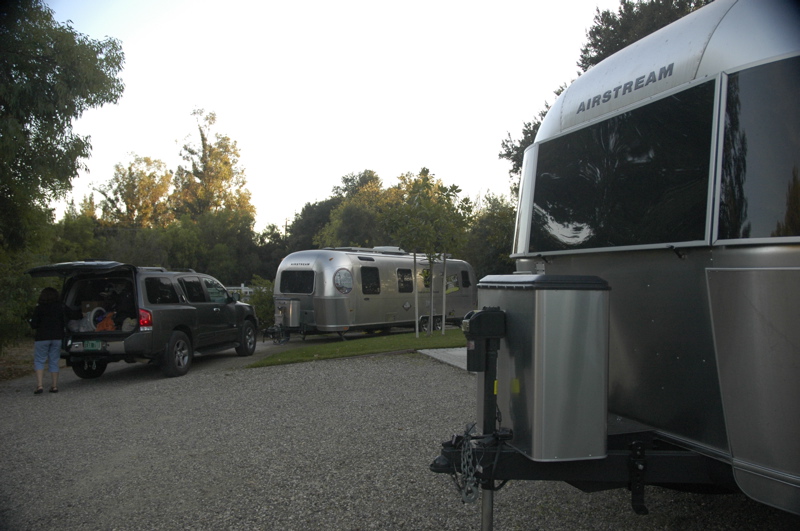
Last night we backed the Airstream into the driveway of our hosts Dennis and Cindy just before sunset. I’ve got to be constantly aware of the short days now, because if we had arrived just 30 minutes later the moderately tricky backing job past trees and around corners would have been escalated to a bona fide “ordeal”. Even in this part of southern California sunset is arriving before 5 p.m., which makes our driving days very short.
Last night Cindy made a great dinner for us all, and so tonight Eleanor is going to reciprocate with an Indian meal. I complain that the Airstream’s cabinets contain too many ingredients and not enough food, and for non-cook like myself that is true. But on nights like this the value becomes clear. Eleanor is able to whip up an amazing ethnic dinner (Indian, Japanese, etc) right out of the masses of diverse ingredients in the cabinets. Since I love foreign food of all types, I can only sit back and admire as she creates something worthy of a genuine Indian restaurant in the space of an Airstream kitchen. Even outdoors in a 20-foot radius around the trailer you can smell the wonderful odors of rogan josh, curry, dal makhani, and palek paneer.
Los Olivos is in horse country, and it seems that nearly every house in the rural areas (which is most of it) has a horse paddock or a small farm growing nuts or berries. Just a short distance from our parking spot is a tiny downtown, which is filled with art galleries and wine tasting rooms. It’s nice, pedestrian-friendly, and pleasantly uncrowded — at least this time of year. I went there today to mail a few boxes of books back to Tucson for storage (we’re trying to lighten the trailer and make some room).
A tip for those of you who are on the road for long periods: look for the Priority Mail “Flat-Rate” boxes at the post office when shipping heavy items like books. You can stuff as much as you want in those boxes regardless of weight (for about $9) but you have to be sure to get the box that says “Flat Rate” on it. We divested ourselves of about 20 lbs of stuff, but more importantly freed up some valuable storage space.
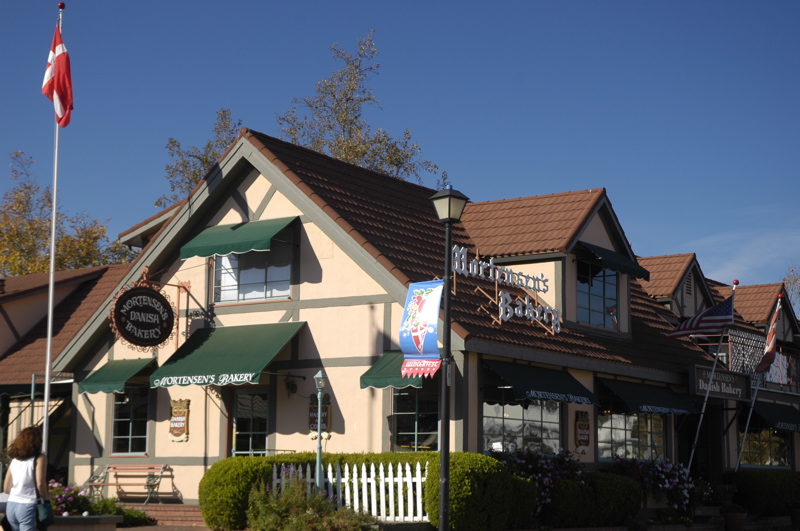
The other neat town near here is Solvang, a “Danish village” according to the billboards. The entire town is themed with Danish and psuedo-Danish architecture, much like Frankenmuth MI but quite a bit larger. Even the Mexican restaurant is clad in a Danish exterior. The overall effect is quaint to a fault, to the point that it begins to resemble EPCOT at DisneyWorld.
The stores are mostly one of these categories: wine shops, gift shops, restaurants, bakeries and inns, so it gets a little redundant after a while. Fortunately, Solvang has managed to keep out the homogenization of chain retail shops, and except for an IZOD Outlet most of the stores seem to be local and unique. That makes it much more interesting. If the outlets take over, Solvang will look like Freeport, Maine in drag.
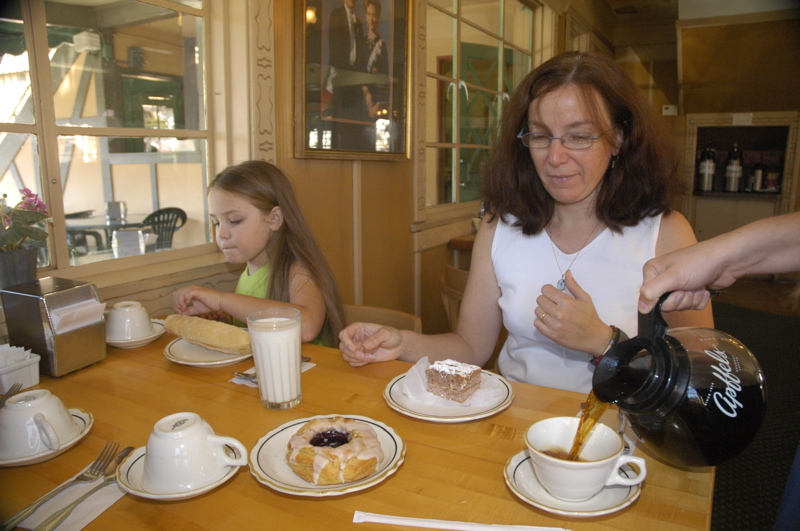
The bakeries and restaurants are my favorite part of Solvang, only because I like to eat anything that doesn’t move quickly. We decided to be totally decadent today and have a pastry lunch at “Mortensen’s Danish Bakery”, and is our practice we all ordered something different: a butter cream-and-raspberry-filled puff pastry for Emma, a raspberry Danish for me, and some sort of almond cake with mocha butter cream for Eleanor. We haven’t been so bad about lunch in a year, when we did the same thing at a little French pastry shop in St Augustine FL. It’s good to be bad once in a while.
November 12, 2007 at 6:30 pm · Filed under Mobile technology, Tips & Ideas
We are so comfortable here in Roger & Roxy’s courtesy parking spot that we have decided to stay a third night. For a “small” California city, Visalia seems to have everything we need for now. Yesterday we knocked off a lot of our to-do list: propane re-fill, a very short haircut for me, a new external hard drive for the Mac, a huge pile of laundry, groceries, and I got a new cell phone.
OK, explanations: The haircut keeps getting shorter because I find life to be easier with short hair. It’s easier to wash when boondocking on short water supplies, and I can let it grow for a few weeks between haircuts (although this last time I waited a bit too long and ended up with a permanent case of the “bed-head” look.) This one is the shortest yet, approaching a crew cut. Anyone who has known me in the past 40 years may be a bit shocked.
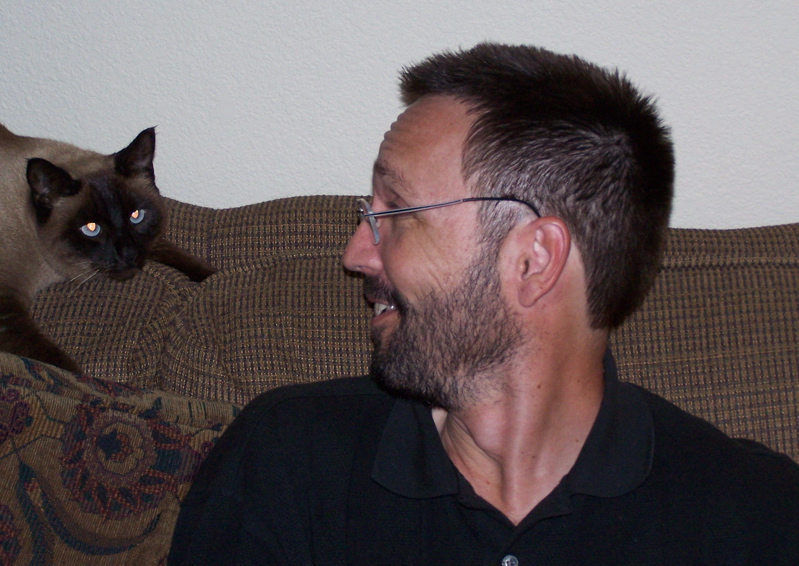
Hard drive: I have need for lots of disk storage because I carry around the complete archives for Airstream Life (layouts, website, articles, correspondence, database, and over 20 gigabytes of photography). The biggest external drives require AC power, which means I would need to run an inverter to use those drives when not plugged in. That is possible, but I find all the cords to be a nuisance, so I use USB-powered drives exclusively.
I was thrilled to find Western Digital’s Passport model that stores 250 gb in a very small form factor and doesn’t need AC power. But when I got it home I found the bad news: it doesn’t work on the Mac Powerbook G4, despite WD’s claim that it is “Mac compatible.” The reason is that it draws more power from the USB port than it should. It works fine with Eleanor’s Mac iBook G4 however. Western Digital has a work-around for this problem, a funky Y-cable that lets it draw power from two USB ports simultaneously, which I will probably get later, although it’s kludgey.
Cell phone: I talk on the phone a lot and believe it or not, under heavy use cell phones do wear out. My last one was purchased in August 2006, when the previous phone croaked out in Idaho. The battery of the replacement phone has had a noticeable loss of capacity and the case is badly worn. I decided to take advantage of Verizon’s upgrade program before the phone died, because the rule of thumb is that cell phones die in the most inconvenient spots. And, this way I’ve got a backup phone in case of failure.
Tomorrow the local Nissan dealer has made room for us on the schedule to get the big 60,000 mile service interval, which will be expensive but is another piece of the mandatory maintenance. That’s 60k miles in two years … yikes … That’s a lot more use from this vehicle than we had originally anticipated. It’s holding up very well, but I wonder if — given our future plans to keep traveling forever — we should consider moving to a diesel vehicle.
We also got a lot of future travel arrangements worked out today, including a bunch of courtesy parking, travel to Vermont (via the dreaded airlines), and a Thanksgiving vacation. So behind the scenes we have managed to get things in fine shape, which means we’re just about ready to start moving again.
Here’s a holiday Airstream-lover tip from correspondent Craig Dreher:
Holidays are coming up fast, so I was on the Airstream site the other day shopping and noticed they had a cookie-cutter in the shape of a Airstream. It didn’t look like our Bambi however. As a result Mary and I were off to Home Depot for a small sheet of aluminum. With a few cuts and rivets, we had ourselves a unique cookie cutter. Totally easy too.
If one took more time than I did, you could probably fashion a handle too.
Check out the cutters and results here
November 5, 2007 at 12:47 am · Filed under FAQs, Tips & Ideas
It has been a very pleasant Sunday. Our overnight parking spot on the street in front of photographer Doug Keister‘s house turned out to be very quiet. Doug gave us a quick tour of Chico, and then did a little photo shoot of Emma for possible inclusion in one of his future projects. By 11:30, we were shoving off and moving south on Rt 99 again, toward tonight’s courtesy parking spot in Amador City, CA.
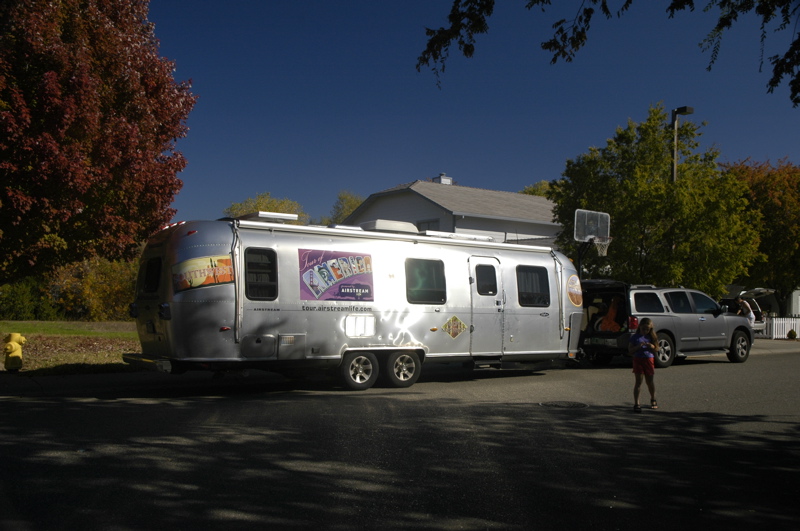
Courtesy parking is one of our favorite modes of “camping.” When you park at someone’s house, you often get the benefit of a fun visit and great insider tips about the local area. Since we’ve been in campgrounds a lot lately, I’ve been looking forward to a few nights of courtesy parking. It makes a nice balance, in addition to saving money.
But campgrounds still constitute the bulk of our nights on the road, so it pays to have a solid understanding of what to look for in a campground. I know from talking to other RV travelers that there is a lot of confusion about this. I’ve rarely talked about the differences between campgrounds, but perhaps it’s time. Campgrounds are not all made equal.
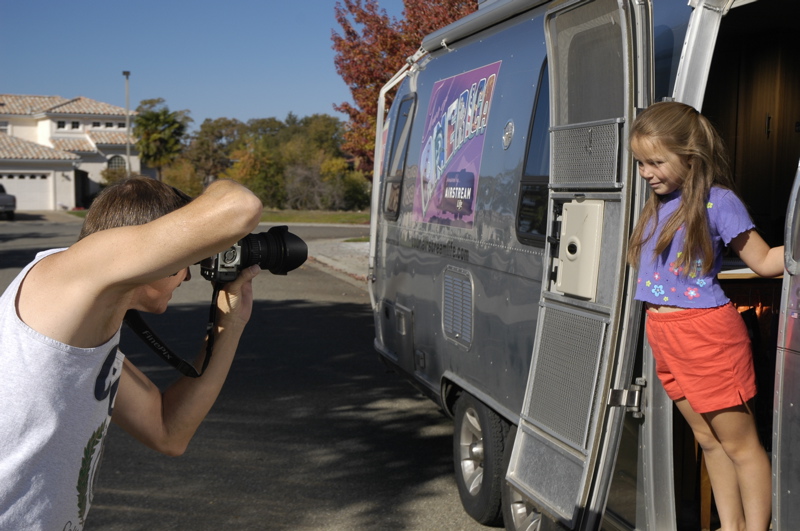
With time, you can develop a sense of what sort of camping experience you’ll get just by looking at the entrance to a campground, or from reading its description in a guide. If we want a scenic, natural, and peaceful experience above all, we tend to avoid places with hundreds of sites, those that are visible from the Interstate, and those with high percentages of permanent residents. Often just the appearance of the entry gate or sign will give a solid clue to the experience that awaits within.
Terms in guidebooks like “big rig friendly,” “laundry, store, and pool,” and “all pull-throughs” are hints that the campground will offer convenience but probably not natural settings. It’s up to you to decide what you want that night. We vacillate between seeking convenience and connectivity (cell phone, Internet), and solitude and natural beauty. In some cases we can find both, but more often a compromise has to be made. My general rule of thumb is that desirability of a spot is inversely proportional to the likelihood of getting online. When we do find a place that offers it all, we stay longer.
There are other clues as well. For example, campgrounds that participate heavily in deep-discount membership programs are generally not in highly desirable locations, but there are exceptions. Most often we find they are at the edge of town or a bit run down. Still, if you’re a member of Passport America, Happy Camper, or other similar programs, the discount often makes up for the minor deficiencies of the campground.
State parks are almost always pleasant but you need to understand each state to know what to expect. In Florida, for example, all state parks with camping have 30-amp electric. In Vermont, none do. Older state parks built during the CCC era (1930s) generally have narrower roads and smaller sites, but nicer settings, so an abundance of CCC-type architecture (stone walls for example) is a clue.
Campgrounds that are predominantly mobile home parks are almost always best avoided. While the sign may say “RV’s welcome”, we’ve never seen one that we’d want to spend money to stay in. However, a lot of RV parks have a small area of fixed or mobile homes off to the side, and those are usually fine.
“55+” is a glaring clue. Since we aren’t over 55 years old, and we travel with a child, we regard “55+” as a sign that the park is filled with stodgy people who have lost their appreciation of children. I appreciate the warning. We’ll go somewhere else. (It’s a shame that these discriminatory “55+” parks are such a plague in Arizona and Florida, however.)
National Forest Service campgrounds, Bureau of Land Management campgrounds, and Corps of Engineers campgrounds can be found in some really spectacular natural areas, and they’re usually cheap. They tend to be in the boondocks. Finding one near where you want to be can be tricky, but if there’s one nearby, they are often pleasantly surprising.
If you’re the sort of person who likes to eat at chain restaurants everywhere you go because you know what to expect, you’ll love big camping chains like KOA. But if you’re the adventuresome type that likes to try the local food wherever you go, you’ll soon learn the subtle cues that lead you to the type of stay you want.
Tonight we are parked at Rob & Sadie’s house in the tiny gold-mining town of Amador City CA. Since we’ll be here two nights, I’ll tell you all about it tomorrow.
October 3, 2007 at 10:07 pm · Filed under Mobile technology, Tips & Ideas
Our admission to the Grizzly and Wolf Discover Center was a two-day ticket, so Emma went back on Tuesday afternoon to join a special kids program. They let the kids go into the bear habitat (when the bears aren’t there, of course) and hide food under the rocks and stumps for the bears to find. This is great fun for the kids and the grizzlies. The kids get to “feed the bears” in a safe and legal fashion, and the grizzlies get to go sniff it out, which keeps their lives interesting.
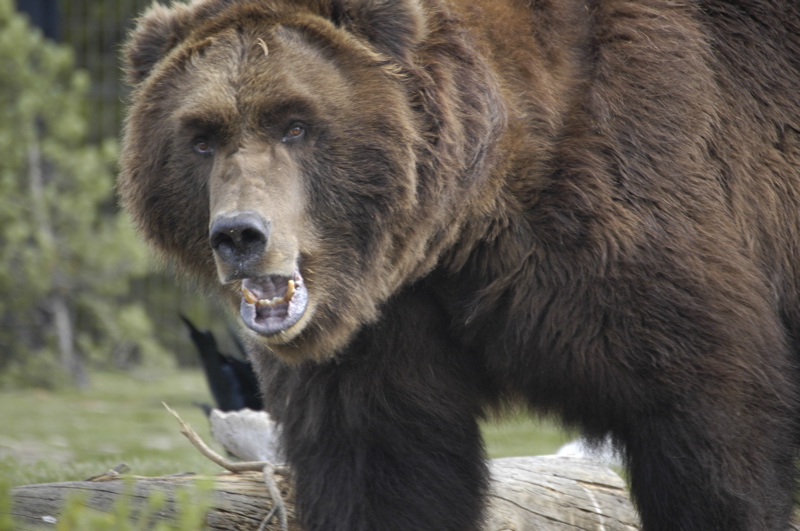
Sam the grizzly bear says “Go ahead, leave some food at your campsite!”
Recovering from a long period offline is serious work. There are the usual emails and phone calls to be caught up on, and replenishing our supplies, and it all tends to happen in a big hurry because we want to be able to do more stuff as soon as possible. So today I spent about 12 hours parked in front of the computer while Emma finished her latest Junior Ranger projects (two of them, for two different Yellowstone patches) and Eleanor dealt with heaps of laundry.
This evening I emerged from the trailer at sunset and found Bert preparing to go into town for a tank of propane, so I put my empty 30# propane tank in his truck and joined him for the ride.
West Yellowstone is a very small town concentrated in about six square blocks at the gate of Yellowstone National Park. It has the look of an Alaskan village, with shabby buildings that show the wear of long hard winters, randomly intermingled with well-kept shops aimed at the tourist trade, and restaurants that sport neon signs. There are three gas stations in two blocks distance, a sign that this is the outpost of Yellowstone and the next gas station is a long way off.
This time of year West Yellowstone is shutting down. The tourists are mostly gone, the skies have gone gray, and the sun is setting before 7 p.m. We counted ourselves lucky to find a place still selling propane after 6 p.m. (a corner convenience store). Bert mentioned this to one of the locals, who snorted, “Are you kidding? West Yellowstone!” as if “West Yellowstone” was a self-explanatory expletive, a code word for avarice or commercialism.
“Not while there’s money to be made,” he went on, but I think his attitude was too vehement to be fair to the town. Yes, it caters to the tourist trade — why else would it be here? — but looking around I can see that the people who make a living here do so at the price of a long winter. I can’t begrudge them trying to make a living during the few short months of summertime activity.
Our campground is more than half empty. I’m sure most of the people who are still here are commuting into Yellowstone, as Bert did today. He was hunting again for the Great Gray Owl, but found a female moose and calf instead. We are seriously considering going back into the park tomorrow together to try for some good photos of the moose, but we’ll need to book another night here first.
I have discovered something annoying about the factory power converter. Our trailer has a Parallax 7300 series converter. It contains a 2-stage battery charger, which means it’s the thing responsible for setting the rate of charge of our batteries when we plug in.
We came out of Yellowstone with our batteries drained about 125 amp-hours and I expected that we’d be re-charged in a day or so. But the Parallax only rapid-charged the batteries for a couple of hours. After that, based on the voltage of the batteries, it stepped down to its “trickle-charge” rate, even though the batteries were still about 70 amp-hours from full.
Since then it has charged at a pathetically slow rate, between 0.37 amps and 1.5 amps. (Our Tri-Metric 2020 system monitor tells us this.) This means our batteries will take days to fully recharge. If we relied on the very basic monitor that comes with nearly all RVs, we’d think we were recharged because a silly little (inaccurate) telltale light would glow green, but the Tri-Metric actually knows better and it tells us the truth.
I’ve been asking for opinions on how to improve this situation from RV electrical system experts, and so far the explanation is that I need to upgrade the Parallax to a 3-stage charger, which is possible but costs over $200 just for the necessary parts. With a third stage that charges at a higher voltage, the Parallax will be much more effective.
Interestingly, we already have a separate 3-stage charge controller in the Airstream (a Blue Sky SolarBoost 2000e) specifically for the solar panels. The Blue Sky unit takes over when sun starts to hit the solar panels. So when the sun comes out, our rate of charge increases dramatically, up as high as 10 amps (actual amperage depends on the amount of sun), and when the sun goes behind a cloud we’re back to the trickle charge level determined by the Parallax. In other words, we can charge much more quickly using a little sunshine than we can when plugged into a 30-amp power cord!
The past few 36 hours have not been very sunny, which (as Dr Seuss would say) seems rather unfunny. We are plugged into all the electrical power we could want, enough to run a heat pump and toaster, but the stupid power converter won’t let our batteries have any!
One partial solution to this quandary is to reduce our power requirements in the future. As several correspondents have pointed out to me, a catalytic heater would eliminate the need to run the energy-robbing furnace and thus reduce our cold-weather power needs by more than half. I agree, and I wish we’d installed a catalytic heater a year ago when I first considered it. We had cat heaters in our previous two Airstreams and loved them for their efficiency and quietness.
For now I am going to take a week or two to consider what to do. Both options presented so far (upgrading the Parallax and adding a catalytic heater) will cost $300-400 each by the time we are done. Also, we are heading into a rather hectic travel period and don’t foresee any long stops for at least several weeks, which makes pausing for service a problem.
I think the immediate thing to do is to go look for moose in Yellowstone while I’ve still got the chance. I’ll get up early in the morning to finalize some work and join Bert for one last photo safari. I can worry about the power situation later.
One final note: this evening Bert, Janie, and I were talking about all the places we’ve met and camped together. We came up with nine states we’ve met in: Maine, Vermont, New Jersey, Florida, Texas, New Mexico, Arizona, Wyoming, and Montana. I love the fact that we are long-distance friends and yet manage to get together for good camping fun all over the country.
October 2, 2007 at 7:12 pm · Filed under Mobile technology, Tips & Ideas
We are back in touch with the world, and I have backdated several blog entries from our trip to Yellowstone. Scroll down to see all the new entries (since September 27).
Last night’s gentle rain turned into freezing rain and then snow, so that this morning when I opened the curtains I found the world outside completely changed from fall to winter with about a half-inch of snow. The balmy sunny weather of just a few days ago seems far off now, with the nearby mountains shrouded in fog and a definite Christmas-y feel to the air.
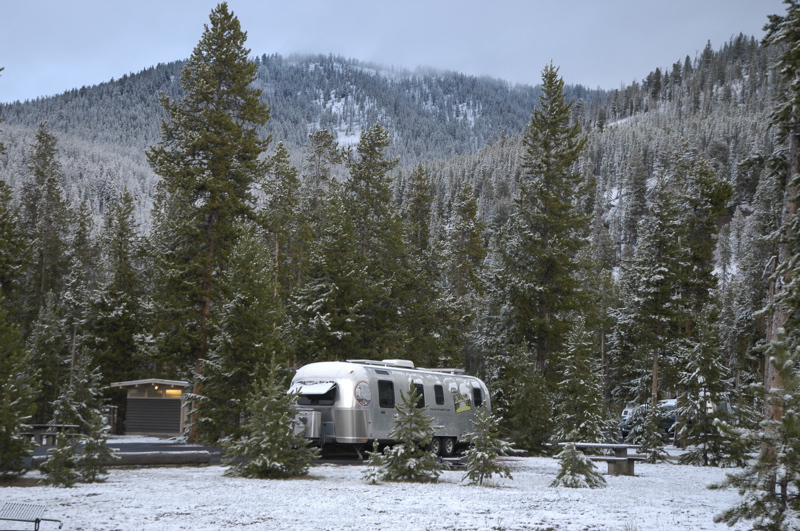
Our entry step was completely coated in ice when I went out, and I found Bert standing at his awning looking at a heap of snow and ice that had coated it and distorted the fabric. He had put his awning out the day before to protect his generator from the rain, but hadn’t anticipated that the rain would become ice.
Like us, Bert and Janie were planning to leave Madison campground today. They were headed off to Grand Teton’s last open campground (Signal Mountain) to find some moose. But first, they had to figure out how to remove inches of snow and ice from their awning and their slide-out. We ended up beating on the ice and sweeping repeatedly, while waiting for the temperature to rise above freezing. Eventually enough was removed for him to roll up the awning and go, but it was far from clean and dry.
I had the same problem with the folding bicycle I’d left cabled to the hitch overnight, but it was easier to de-ice. I hauled it into the Airstream and let it melt on a towel for an hour.
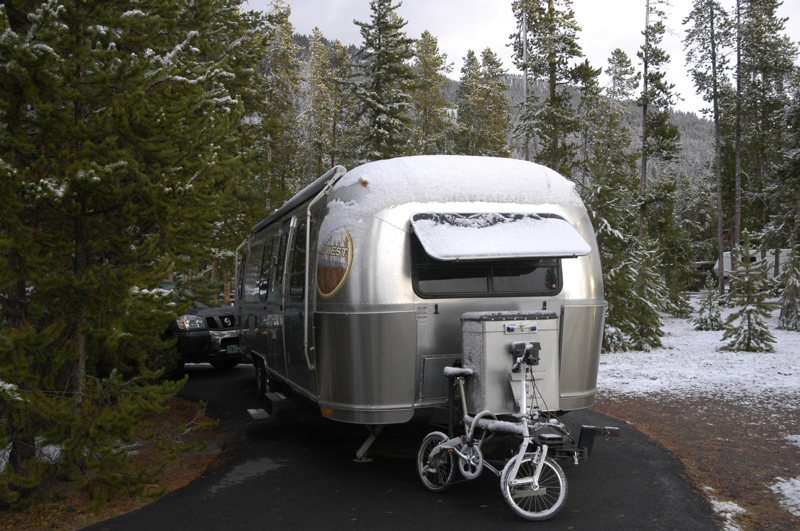
Yellowstone is just as beautiful in the snow as it was last week in the sun. The meadows glow gold when struck by the light, and the broad flat rivers still glisten and burble and sprout fly-fishermen in hip waders. The mountains are draped with cloud and the bison are coated with frost on their dark woolly manes.
It all works so well that I almost began to despair at the excess of photographic opportunities. There simply wasn’t enough time, even in six days and nights, to begin to capture this place. I shot over eight hundred photographs (culled to about 400 hundred at this point, and still going). It wasn’t enough.
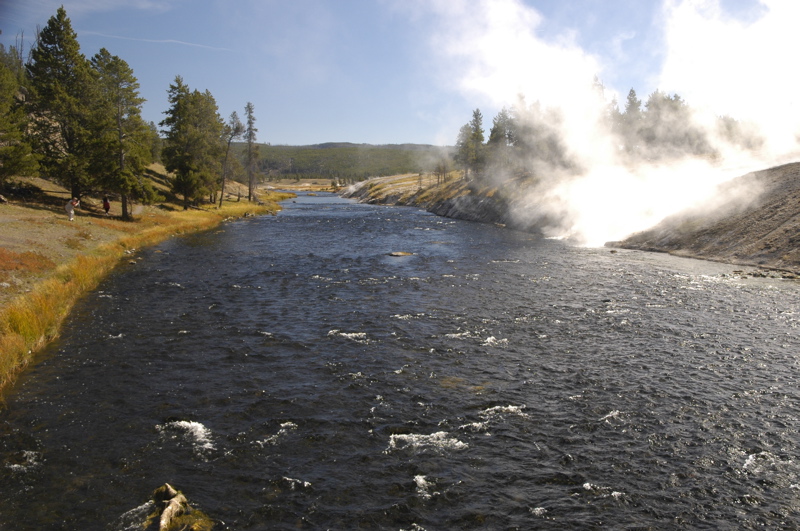
Steaming hot water pours down from Grand Prismatic Geyser into the Firehole River
We came out of the six-night “no-hookup” camping experience in Yellowstone surprisingly well. Despite trees shading our solar panels, freezing temperatures every night, and a few cloudy days, we emerged with this final status:
28 degrees at 8:00 a.m. Snow on panels. -133 amp-hours cumulative (50 amp-hours used overnight)
That’s not bad at all. As I noted when we left Cody, our safe useful battery power is 150 amp-hours (out of 300 total in the bank), and even after six nights we didn’t hit our limit. The key was serious conservation, primarily by keeping the furnace set low at night. We settled on 50 degrees as our overnight setting, which wasn’t bad at all with a lot of blankets on the beds. Bert and Janie set theirs at 40 degrees and sleep in sleeping bags. This morning we met a fellow in a fifth wheel who says his insulation is virtually non-existent and so they just turn off the furnace at night. Compared to them, we are total weenies.
Water-wise we did even better. Our 39-gallon fresh water tank was still about 1/3 full when we left. We took a total of six showers between us (with minor sponge baths from the sink between showers), used the bathroom at night, and did a few dishes when we didn’t feel like going out to the campground sink. It was really great to test our ability to camp on minimal resources, like the old days when we were tenting, and know what our Airstream can do.
Some of you may be reading this and thinking, “How horrible — sponge baths, a cold trailer, no TV,” but really it’s fun. It’s a game to see how long we can stretch a gallon of water, how long we can make a battery last, and how well we can keep ourselves entertained in a place with relatively few of the modern distractions.
After six nights it was time to go find a place to replenish our supplies. We’re now in a commercial campground in the little town of West Yellowstone MT, just a half mile from the park gate. This place has what we need for the next few days: electrical power, stores, cell phone service, Internet, propane. I’m going to sit down before my computer and get some progress on the layouts for the upcoming Winter 2007 magazine, and we’ll also re-stock for a few more days of boondocking in Montana next week.
Bert & Janie got skunked on their plan to head down to Grand Teton. The snow last night caused road closures heading south, and they were forced back north. They also heard from Eric and Sue that the moose were being elusive. So now they’re here, parked right next to us for the next two days, doing the same things we are. Well, except for one thing: Bert had to open his awning up again to melt the last of the ice that got rolled up in it this morning. Now it looks normal again.
Once we’re all caught up, the plan is to head up to some ghost towns in Montana, but I’ll tell you about that later.
« Previous entries ·
Next entries »
 Two weeks of intervening time has given poor Sharon a chance to get over her disaster, and she’s been enjoying the peacefulness of the park while she works remotely on magazine designs for her clients. Since she’s a portable professional like me, the time has been useful and frankly there are a lot worse places to be “stuck” for two weeks than South Llano River State Park.
Two weeks of intervening time has given poor Sharon a chance to get over her disaster, and she’s been enjoying the peacefulness of the park while she works remotely on magazine designs for her clients. Since she’s a portable professional like me, the time has been useful and frankly there are a lot worse places to be “stuck” for two weeks than South Llano River State Park.













